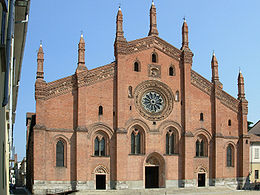
Santa Maria del Carmine, Pavia
Encyclopedia

Pavia
Pavia , the ancient Ticinum, is a town and comune of south-western Lombardy, northern Italy, 35 km south of Milan on the lower Ticino river near its confluence with the Po. It is the capital of the province of Pavia. It has a population of c. 71,000...
, Lombardy
Lombardy
Lombardy is one of the 20 regions of Italy. The capital is Milan. One-sixth of Italy's population lives in Lombardy and about one fifth of Italy's GDP is produced in this region, making it the most populous and richest region in the country and one of the richest in the whole of Europe...
, northern Italy
Italy
Italy , officially the Italian Republic languages]] under the European Charter for Regional or Minority Languages. In each of these, Italy's official name is as follows:;;;;;;;;), is a unitary parliamentary republic in South-Central Europe. To the north it borders France, Switzerland, Austria and...
, considered amongst the best examples of Lombard Gothic architecture
Gothic architecture
Gothic architecture is a style of architecture that flourished during the high and late medieval period. It evolved from Romanesque architecture and was succeeded by Renaissance architecture....
. It was begun in 1374 by Gian Galeazzo Visconti
Gian Galeazzo Visconti
Gian Galeazzo Visconti , son of Galeazzo II Visconti and Bianca of Savoy, was the first Duke of Milan and ruled the late-medieval city just before the dawn of the Renaissance...
, Duke of Milan, on a project attributed to Bernardo da Venezia. The construction followed a slow pace, and was restarted in 1432, being finished in 1461.
Exterior
The church has an imposing façade commanding the square with the same name; the slender forms betray a residual RomanesqueRomanesque architecture
Romanesque architecture is an architectural style of Medieval Europe characterised by semi-circular arches. There is no consensus for the beginning date of the Romanesque architecture, with proposals ranging from the 6th to the 10th century. It developed in the 12th century into the Gothic style,...
influence, although the decorations are undoubutably of Lombard Gothic style. The façade is divided into five vertical compartments by six pilasters surmounted by spire
Spire
A spire is a tapering conical or pyramidal structure on the top of a building, particularly a church tower. Etymologically, the word is derived from the Old English word spir, meaning a sprout, shoot, or stalk of grass....
s. The three central sectors have a portal each, remade by Giuseppe Marchesi in 1854. Over the portals are four large ogival mullioned windows and an elaborated rose window
Rose window
A Rose window is often used as a generic term applied to a circular window, but is especially used for those found in churches of the Gothic architectural style and being divided into segments by stone mullions and tracery...
in brickwork.
The bell tower, dating to c. 1450, has numerous friezes and a triple mullioned window with marble columns.
Interior
The interior is characterized by an inspiring penumbra, and is on the Latin cross plan with a nave and numerous lateral chapels with frescoes and paintings. The most important are:- 2nd Chapel, with a fresco by Vincenzo FoppaVincenzo FoppaVincenzo Foppa was a Northern-Italian Renaissance painter.He was an elderly contemporary of Leonardo da Vinci. Born at Bagnolo Mella, near Brescia in the Republic of Venice, he settled in Pavia around 1456, serving the dukes of Milan and emerging as one of the most prominent Lombard painters....
(1462) - 4th Chapel, with a canvas of the Guardian Angel by Sebastiano RicciSebastiano RicciSebastiano Ricci was an Italian painter of the late Baroque school of Venice. About the same age as Piazzetta, and an elder contemporary of Tiepolo, he represents a late version of the vigorous and luminous Cortonesque style of grand manner fresco painting.-Early years:He was born in Belluno, son...
(1694) - 5th Chapel, with an Assumption by Bernardo Cane
- 6th Chapel, with an altarpiece of St. Anne and the Wool Making Craft (by Guglielmo CacciaGuglielmo CacciaGuglielmo Caccia called il Moncalvo was an Italian painter who specialised in altar-pieces.He was born in Montabone near Acqui. He said to have been a pupil of Lorenzo Sabbatini. He started painting in Milan, then worked in Pavia, where he was made a citizen...
) - 7th Chapel, housing a Gothic altarpiece donated by Pius X, and 15th century polyptych with Madonna and Saints (by Bernardino da Cotignola).
In the transept are also precious 15th century frescoes, while the sacristy (1576) has façade with Baroque stuccoes. Also notable is the Gothic tabernacle (1449) and the marble altar of the presbytery.

